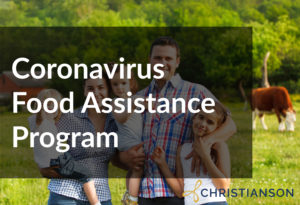Coronavirus Food Assistance Program (CFAP 2)
The Coronavirus Food Assistance Program will provide a second round of direct relief (CFAP 2) to producers who faced price declines and additional costs due to COVID-19.
About the Coronavirus Food Assistance Program

According to the USDA: President Donald J. Trump and U.S. Secretary of Agriculture Sonny Perdue announced on September 17 that USDA will implement an expansion of the Coronavirus Food Assistance Program. Coronavirus Food Assistance Program 2 (CFAP 2) will provide producers with financial assistance to help offset some of the increased costs associated with the COVID-19 pandemic. The CFAP 2 effective payment rate for crops will be multiplied by acreage and the APH yield. Here are the effective payment rates broken down by crop:
USDA’s Farm Service Agency will accept CFAP 2 applications from September 21 through December 11, 2020.
Eligible Producers
Any individual or legal entity who shares in the risk of producing a commodity may apply for CFAP 2. Producers must be in the business of farming at the time of submitting their application to be eligible. Contract growers who do not share in the price risk of production are ineligible. Producers can apply for assistance for only commercially produced commodities.
To be eligible for payments, a person or legal entity must have an average adjusted gross income of less than $900,000 for tax years 2016, 2017, and 2018. However, if 75 percent or more of their adjusted gross income comes from farming, ranching, or forestry-related activities, the AGI limit of $900,000 does not apply and the person or legal entity is eligible to receive CFAP 2 payments up to the applicable payment limitation.
Payment Limitations
The total CFAP 2 payment that a person or legal entity may receive, directly or indirectly through attribution of payments, is $250,000. As this is a separate program, this payment limitation is separate from the CFAP 1 payment limit. This limitation applies to the total amount of CFAP 2 payments made with respect to all eligible commodities.
The total amount of CFAP 2 payments made to a legal entity – such as to a corporation, limited liability corporation, limited partnership, trust, or estate – is $250,000 except if:
- two different members of the legal entity each provide at least 400 hours of active personal labor, active personal management, or combination thereof with respect to the production of 2020 commodities, then an entity may receive up to $500,000.
- three different members of the legal entity each provide at least 400 hours of active personal labor, active personal management, or combination thereof with respect to the production of 2020 commodities, then an entity may receive up to $750,000.
Although the payment limitation is increased for the corporation, LLC, LP, trust, or estate, each members’ payment limitation (received directly or indirectly) remains subject to the $250,000 individual person payment limit.
These payment limit provisions are different from and separate from the payment limitations established by the 2018 Farm Bill.
Eligible Commodities for CFAP 2
Coronavirus Food Assistance Program 2, or CFAP 2, will provide producers with financial assistance that gives them the ability to absorb some of the increased marketing costs associated with the COVID-19 pandemic. USDA will accept applications from September 21, 2020 through December 11, 2020. Learn more at farmers.gov/cfap.
CFAP 2 payments will be made for three categories of commodities – Price Trigger Commodities, Flat-Rate Crops, and Sales Commodities. Eligible commodities for each category are outlined below.
Price Trigger Commodities
Price trigger commodities are major commodities that meet a minimum five-percent price decline over a specified period of time. Price trigger commodities eligible for CFAP 2 are outlined below.
- Broilers and eggs
- Crops: barley, corn, sorghum, soybeans, sunflowers, upland cotton, and all classes of wheat.
- Dairy (cow’s milk)
- Livestock: beef cattle, hogs and pigs, and lambs and sheep. Animals raised for breeding stock are not eligible for CFAP 2.
Flat-Rate Crops
Flat-rate crops either do not meet the five-percent price decline trigger or do not have data available to calculate a price change.
Flat-rate crops include: alfalfa, amaranth grain, buckwheat, canola, Extra Long Staple (ELS) cotton, crambe (colewort), einkorn, emmer, flax, guar, hemp, indigo, industrial rice, kenaf, khorasan, millet, mustard, oats, peanuts, quinoa, rapeseed, rice, sweet rice, wild rice, rye, safflower, sesame, speltz, sugar beets, sugarcane, teff, and triticale.
Sales Commodities
Sales commodities eligible for CFAP 2 include specialty crops, aquaculture, nursery crops and floriculture, and other commodities not included in the price trigger and flat-rate payment categories.
Eligible sales commodities are outlined below:
- Aquaculture
- Dairy (goat’s milk)
- Floriculture and Nursery Crops:
- Cactus
- Christmas trees
- Floriculture
- Nursery crops
- Specialty Crops
- Fruits
- Honey
- Horticulture
- Maple sap
- Tree Nuts
- Vegetables
- Specialty Livestock
- Tobacco
- Wool
You can read the full list of sales commodities eligible for CFAP 2 here.
Ineligible Commodities
Commodities not eligible for CFAP 2 include:
- Hay, except for alfalfa, and crops intended for grazing.
- All equine, animals raised for breeding stock, companion or comfort animals, pets, and animals raised for hunting or game purposes.
- Birdsfoot and trefoil, clover, cover crop, fallow, forage soybeans, forage sorghum, gardens (commercial and home), grass, kochia (prostrata), lespedeza, milkweed, mixed forage, pelts (excluding mink), perennial peanuts, pollinators, sunn hemp, vetch, and seed of ineligible crops.
To complete the CFAP 2 application, producers will need to reference their sales, inventory, and other records. However, since this is a self-certification program, this documentation will not need to be submitted with the application. Because applications are subject to County Committee review and spot check, some producers will be required to provide documentation. Producers should retain the records and documentation they use to complete the application. Information on additional documents is provided at farmers.gov/cfap/apply.
If you have questions about the CFAP 2, contact our experts today!
[button_1 text=”Contact%20Christianson%20Today!” text_size=”15″ text_color=”#ffffff” text_font=”Lato;google” text_letter_spacing=”1″ subtext_panel=”N” text_shadow_panel=”N” styling_width=”30″ styling_height=”20″ styling_border_color=”#ffffff” styling_border_size=”5″ styling_border_radius=”23″ styling_border_opacity=”100″ styling_gradient_start_color=”#1b335d” styling_gradient_end_color=”#1b335d” drop_shadow_panel=”N” inset_shadow_panel=”N” align=”center” href=”https://www.christiansoncpa.com/contact-us/”/]





